Click on images to enlarge

habit (Photo: Sheldon Navie)

habit in flower (Photo: Sheldon Navie)

habit in fruit (Photo: Rob and Fiona Richardson)
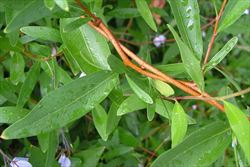
elongated leaves and reddish-brown twining stems (Photo: Sheldon Navie)

drooping flowers in small clusters (Photo: Sheldon Navie)
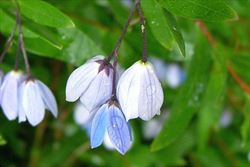
close-up of flowers of different ages showing small purplish sepals. Note the brighter blue younger flower and the oldest flower has already lost its sepals (Photo: Sheldon Navie)

close-up of leaf underside and flowers from below, showing yellowish stamens that are appressed to each other (Photo: Sheldon Navie)

elongated leaves and young fruit (Photo: Greg Jordan)
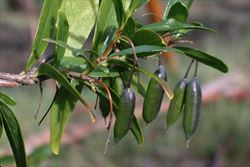
immature fruit (Photo: Rob and Fiona Richardson)
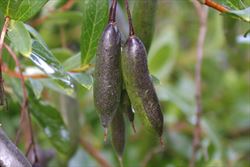
close-up of purplish-green immature fruit (Photo: Rob and Fiona Richardson)
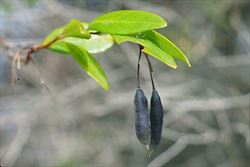
purplish-black mature fruit (Photo: Jackie Miles and Max Campbell)
Scientific Name
Billardiera fusiformis Labill.
Note: Billardiera fusiformis has been confused with Billardiera heterophylla in the past, often being included within a broad definition of that species. Recent research has confirmed that Billardiera fusiformis is indeed a separate species. Herbaria in most states have yet to reflect this change and currently classify naturalised plants as simply either Sollya heterophylla or Billardiera heterophylla.
Synonyms
Billardiera elongata Schnizl.Billardiera hambruchiana Seem. & J.C. SchmidtBillardiera heterophylla (Lindl.) L.W. Cayzer & Crisp (misapplied)Billardiera salicifolia F. CelsLabillardiera fusiformis (Labill.) Schult.Sollya fusiformis (Labill.) PayerSollya heterophylla Lindl.Sollya heterophylla Lindl. var. linearis (Lindl.) Pax.Sollya heterophylla Lindl. var. salicifolia Ser.Sollya linearis Lindl.Sollya salicifolia Marnock
Family
Pittosporaceae
Common Names
Australian blue-bell, Australian bluebell, Australian bluebell creeper, blue-bell creeper, bluebell creeper, native bluebell, purple appleberry, sollya, WA blue bell, WA bluebell creeper, Western Australian bluebell, West Australian bluebell creeper, Western Australian bluebell creeper
Origin
This species is native to some parts of south-western Western Australia, however its exact natural distribution has been obscured by its cultivation for horticultural purposes over the last century. Bluebell creeper (Billardiera fusiformis) may have only grown naturally in the southern coastal districts of Western Australia, but it is now very widespread over large parts of south-western and southern Western Australia.
Cultivation
This species has been widely cultivated as ornamental garden plant in the temperate regions of southern Australia.
A sterile horticultural hybrid, known as Edna Walling blue bells (Billardiera heterophylla x Billardiera parviflora), is now becoming more popular in cultivation as it is thought to be less invasive.
Naturalised Distribution
Widely naturalised in south-eastern Australia (i.e. in the central and southern tablelands regions of New South Wales, in the ACT, in Victoria and Tasmania, and in south-eastern South Australia).
Note: While it is thought that both Billardiera fusiformis and Billardiera heterophylla are cultivated as horticultural plants, it seems that the majority of cultivated and naturalised specimens in Australia actually belong to Billardiera fusiformis. The most recent Victorian Plant Census reflects this by only recognising Billardiera fusiformis as being naturalised in Victoria. Therefore, it is highly likely that most, if not all, of the naturalised populations of bluebell creeper in other states are also attributable to Billardiera fusiformis, though they have yet to be re-classified as such.
Habitat
Bluebell creeper (Billardiera fusiformis) grows naturally in eucalypt woodlands and open forests, in coastal heathlands and around inland salt lakes in Western Australia. It is also an aggressive coloniser of disturbed sites in this region.
Where this species has become naturalised in south-eastern Australia, it grows in similar habitats to those that it occupies in its native range (i.e. sclerophyll forests, shrublands and disturbed sites).
Habit
A long-lived (i.e. perennial) and relatively sturdy climbing plant with numerous twining stems that is rarely shrubby or bushy in habit.
Distinguishing Features
-
a long-lived climbing plant that is rarely shrubby or bushy in habit.
-
its older stems are reddish-brown while newer stems are greenish in colour and densely hairy.
-
its elongated leaves are almost stalkless with entire margins and softly hairy surfaces.
-
its nodding blue (occasionally white or pink) flowers are arranged in small clusters at the tips of the branches.
-
these flowers have five petals (6-11 mm long) and five yeoowish stamens, which are usually appressed to each other.
-
its cylindrical fruit (less than 20 mm long) are narrowed slightly towards each end and are dark green or purplish in colour.
Seedling
The seedlings have two narrow seed leaves (i.e. linear cotyledons). The firts true leaves are relatively broad and bluntly toothed (i.e. crenate) at first, but rapidly become entire and narrowly oval in shape as the seedling grows.
Stems and Leaves
Older stems are reddish-brown or greyish-brown in colour and somewhat angular in shape, while younger stems are greenish in colour and densely hairy (i.e. villous).
The alternately arranged leaves (10-50 mm long and 2-15 mm wide) are elongated in shape (i.e. linear to narrow-elliptic) and almost stalkless (i.e. sub-sessile). Their margins are entire or slightly wavy (i.e. uldulate) with shortly-pointed tips (i.e. acute or mucronate apices). Both leaf surfaces are softly hairy at first, but they may become almost hairless (i.e. glabrescent) with age.
Flowers and Fruit
The nodding or drooping flowers (about 1 cm wide) are arranged in small clusters at the tips of the branches (i.e. in terminal cymes of one to three, or rarely up to five, flowers). Each flower is borne on a slender stalk (i.e. pedicel) 6-10 mm long. These flowers have five small hairy sepals (2-3 mm long) that are purplish in colour and joined together at the base. They also have five petals (6-11 mm long and about 3 mm wide) with shortly-pointed (i.e. cuspidate) tips. These petals are usually bright blue at first (occasionally white, mauve or pink), but their colour quickly fades with age. The flowers also have five stamens, which are usually appressed to each other but not fused, and an ovary topped with a style (about 5 mm long) and tiny stigma. The stamens have short filaments that are equal to or shorter than their yellowish anthers (3.5-4.5 mm long). Flowering occurs maotly during late spring and summer.
The cylindrical fruit (less than 20 mm long) are narrowed slightly towards each tip (i.e. they are fusiform), and are either dark green or purplish in colour. They contain numerous small reddish-brown seeds 2-3 mm long. These fruit are present during summer and autumn.
Reproduction and Dispersal
Bluebell creeper (Billardiera fusiformis) reproduces mainly by seed, though it also readily produces shoots from its underground rootstock if its aboveground parts are damaged. The climbing stems are also capable of rooting at their joints (i.e. nodes) when they come into contact with soil.
Seeds are mostly dispersed by birds and other animals that eat the fruit, but they may also be spread in dumped garden waste.
Environmental Impact
Bluebell creeper (Billardiera fusiformis) is regarded as a significant environmental weed in Victoria and as a moderately important environmental weed in South Australia, Tasmania, New South Wales and the ACT. During a recent survey, it was also listed as a priority environmental weed in two Natural Resource Management regions. This species invades grassy woodlands, sclerophyll forests, shrublands, lowland grasslands, riparian areas and heathy vegetation it wetter temperate regions. It smothers the ground flora and grows over smaller shrubs, with masses of seedlings emerging following fires in infested coastal woodlands.
In Victoria, bluebell creeper (Billardiera fusiformis) is regarded as a very serious threat to one or more vegetation formations. The major infestations of this species are present in the coastal areas in the south of the state, and it appears on numerous local environmental weed lists in this region (e.g. in Monash City, Knox City and the Mornington Peninsula Shire). It is also regarded as a threat to the remaining populations of the endangered native purple eyebright (Euphrasia collina subsp. muelleri) in Victoria.
Bluebell creeper (Billardiera fusiformis) is a common environmental weed of the greater Adelaide region and Mount Lofty Ranges in south-eastern South Australia. It has also been reported to be smothering endemic native vegetation in the Mount Burr Native Forest in the far south-east of this state. While currently less troublesome in New South Wales, this species appears on weed lists in the cooler parts of the state (e.g. in the NSW Southern Highlands and the Blue Mountains region) and is one of the species of "exotic vines and scramblers" whose invasion of native vegetation is listed as a "key threatening process" in New South Wales. It is also escaping cultivation in gardens in the Canberra region, and is being monitored and managed in nature conservation areas in the ACT.
Bluebell creeper (Billardiera fusiformis) has also been recorded in conservation areas in Victoria (e.g. Phillip Island Nature Park, Churchill National Park, Lysterfield Park and Dandenong Ranges National Park), South Australia (e.g. Belair National Park and Black Hill Conservation Park) and Tasmania (e.g. Don Reserve and Greens Beach/Kelso Coastal Reserve).
Legislation
Not declared or considered noxious by any state government authorities.
Management
For information on the management of this species see the following resources:
- the Victorian Department of Natural Resources and Environment Coastal Note on this species, which are available online at http://www.dpi.vic.gov.au.
- Muyt (2001), Bush Invaders of South-east Australia, pp. 149-150.
Similar Species
Billardiera fusiformis can be distinguished from Billardiera heterophylla by the following differences:
- Billardiera fusiformis generally has a climbing or twining habit (rarely shrubby) and its relatively narrow (i.e. linear to narrowly elliptic) adult leaves are entire and almost stalkless. Its flower sepals are all about the same size and its anthers are noticeably longer than their filaments. Its fruit are somewhat spindle-shaped (i.e. fusiform).
- Billardiera heterophylla generally has a shrubby habit with some climbing stems and its relatively broad (i.e. elliptic to ovate) adult leaves are finely toothed and borne on short stalks (2-3 mm long). Its flower sepals are of different sizes and its anthers are about the same length as their filaments. Its fruit are cylindrical in shape.
Their are numerous other native apple-berries (Billardiera spp.) that may be confused with the bluebell creepers (Billardiera fusiformis and Billardiera heterophylla), however the majority do not have blue flowers. For accurate identification of these species consult an expert text (e.g. Cayzer et al. 2004).

